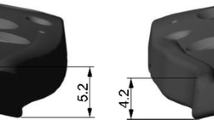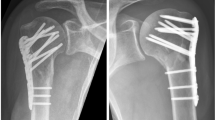Abstract
Background
Metal plates are the fixation devices used most frequently to proximal humeral fractures (PHFs). However, in recent years carbon fiber-reinforced polyetheretherketone (CFR-PEEK) plates have become increasingly common. This study compares the clinical and radiographic outcomes of 42 Neer three- and four-part PHFs treated with CFR-PEEK or metal (titanium) plates.
Materials and methods
Forty-two PHF patients were managed with CFR-PEEK plates (n = 21, males/females 9/12; mean age 57.4 years; mean follow-up 30.7 months; CFR-PEEK group) or metal plates (n = 21; males/females 7/14; mean age 55.8 years; mean follow-up 52.7 months; Metal group). Active shoulder mobility (anterior elevation, lateral elevation, external rotation, and internal rotation), the Constant–Murley Score, the Simple Shoulder Test Score, and the pain score were recorded. Preoperative computed tomography scans and X-rays were obtained. Postoperative fracture healing and displacement, tuberosity resorption and/or malposition, hardware position, and cortical thinning (CT) under the plate were assessed radiographically.
Results
Shoulder mobility, clinical, and pain scores were similar in both patient groups. CT was significantly greater in CFR-PEEK patients (mean difference, 1.14 mm; p = 0.0003). In both groups, incomplete or poor calcar reduction was associated to a significantly higher complication rate, especially stiffness and muscle weakness (p = 0.016). The rate of tuberosity resorption was significantly higher in the Metal group (p = 0.040). Two patients required revision to a hemiarthroplasty (CFR-PEEK) and reverse arthroplasty (Metal group).
Conclusions
CFR-PEEK plates provide a viable alternative to conventional titanium plates in PHFs, ensuring similar clinical outcomes and a lower rate of tuberosity resorption, but they involve higher stress shielding under the plate.






Similar content being viewed by others
References
Launonen AP, Lepola V, Saranko A, Flinkkilä T, Laitinen M, Mattila VM (2015) Epidemiology of proximal humerus fractures. Arch Osteoporos 10:209. https://doi.org/10.1007/s11657-015-0209-4
Passaretti D, Candela V, Sessa P, Gumina S (2017) Epidemiology of proximal humeral fractures: a detailed survey of 711 patients in a metropolitan area. J Shoulder Elb Surg 26:2117–2124. https://doi.org/10.1016/j.jse.2017.05.029
Roux A, Decroocq L, El Batti S, Bonnevialle N, Moineau G, Trojani C et al (2012) Epidemiology of proximal humerus fractures managed in a trauma center. Orthop Traumatol Surg Res 98:715–719. https://doi.org/10.1016/j.otsr.2012.05.013
Palvanen M, Kannus P, Niemi S, Parkkari J (2006) Update in the epidemiology of proximal humeral fractures. Clin Orthop Relat Res 442:87–92
Court-Brown CM, Garg A, McQueen MM (2001) The epidemiology of proximal humeral fractures. Acta Orthop Scand 72:365–371
Lee SH, Dargent-Molina P, Br_eart G (2002) Risk factors for fractures of the proximal humerus: results from the EPIDOS prospective study. J Bone Miner Res 17:817–825. https://doi.org/10.1359/jbmr.2002.17.5.817
Neer CN (1970) Displaced proximal humeral fractures. I. Classification and evaluation. J Bone Jt Surg Am 52:1077–1089
Gaebler C, McQueen MM, Court-Brown CM (2003) Minimally displaced proximal humeral fractures: epidemiology and outcome in 507 cases. Acta Orthop Scand 74:580–585. https://doi.org/10.1080/00016470310017992
Handoll HH, Gibson JN, Madhok R (2003) Interventions for treating proximal humeral fractures in adults. Cochrane Database Syst Rev. https://doi.org/10.1002/14651858.cd000434
Schumaier A, Grawe B (2018) Proximal Humerus fractures: evaluation and management in the elderly patient. Geriatr Orthop Surg Rehabil 9:1–11. https://doi.org/10.1177/2151458517750516
Zhao W, Zhang Y, Johansson D, Chen X, Zheng F, Li L (2017) Comparison of minimally invasive percutaneous plate osteosynthesis and open reduction internal fixation on proximal humeral fracture in elder patients: a systematic review and meta analysis. Biomed Res Int. https://doi.org/10.1155/2017/3431609
Sproul RC, Iyengar JJ, Devcic Z, Feeley BT (2011) A systematic review of locking plate fixation of proximal humerus fractures. Injury 42:408–413. https://doi.org/10.1016/j.injury.2010.11.058
Laux CJ, Grubhofer F, Werner CML, Simmen HP, Osterhoff G (2017) Current concepts in locking plate fixation of proximal humerus fractures. J Orthop Surg Res 12:137. https://doi.org/10.1186/s13018-017-0639-3
Huttunen TT, Launonen AP, Pihlajamäki H, Kannus P, Mattila VM (2012) Trends in the surgical treatment of proximal humeral fractures—a nationwide 23-year study in Finland. BMC Musculoskelet Disord 13:261. https://doi.org/10.1186/1471-2474-13-261
Spross C, Zeledon R, Zdravkovic V, Jost B (2017) How bone quality may influence intraoperative and early postoperative problems after angular stable open reduction-internal fixation of proximal humeral fractures. J Shoulder Elb Surg 26:1566–1572. https://doi.org/10.1016/j.jse.2017.02.026
Giannotti S, Bottai V, Dell’osso G, Donati D, Bugelli G, De Paola S et al (2012) Indices of risk assessment of fracture of the proximal humerus. Clin Cases Miner Bone Metab 9:37–39
Gregory TM, Vandenbussche E, Augereau B (2013) Surgical treatment of three and four-part proximal humeral fractures. Orthop Traumatol Surg Res 99:S197–S207. https://doi.org/10.1016/j.otsr.2012.12.006
Dilisio MF, Nowinski RJ, Hatzidakis AM, Fehringer EV (2016) Intramedullary nailing of the proximal humerus: evolution, technique, and results. J Shoulder Elb Surg 25:e130–e138. https://doi.org/10.1016/j.jse.2015.11.016
Schumer RA, Muckley KL, Markert RJ, Prayson MJ, Heflin J, Konstantakos EK et al (2010) Biomechanical comparison of a proximal humeral locking plate using two methods of head fixation. J Shoulder Elb Surg 19:495–501. https://doi.org/10.1016/j.jse.2009.11.003
Yamamoto N, Hongo N, Berglund L, Sperling J, Cofield R, An K (2013) Biomechanical analysis of a novel locking plate with smooth pegs versus a conventional locking plate with threaded screws for proximal humerus fractures. J Shoulder Elb Surg 22:445–450. https://doi.org/10.1016/j.jse.2012.04.005
Katthagen JC, Schwarze M, Warnhoff M, Voigt C, Hurschler C, Lill H (2016) Influence of plate material and screw design on stiffness and ultimate load of locked platingin osteoporotic proximal humeral fractures. Injury 47:617–624. https://doi.org/10.1016/j.injury.2016.01.004
Katthagen JC, Ellwein A, Lutz O, Voigt C, Lill H (2017) Outcomes of proximal humeral fracture fixation with locked CFR-PEEK plating. Eur J Orthop Surg Traumatol 27:351–358. https://doi.org/10.1007/s00590-016-1891-7
Feerick EM, Kennedy J, Mullett H, FitzPatrick D, McGarry P (2013) Investigation of metallic and carbon fibre PEEK fracture fixation devices for three part proximal humeral fractures. Med Eng Phys 35:712–722. https://doi.org/10.1016/j.medengphy.2012.07.016
Steinberg EL, Rath E, Shlaifer A, Chechik O, Maman E, Salai M (2013) Carbon fiber reinforced PEEK Optima:composite material biomechanical properties and wear/debris characteristics of CF PEEK composites for orthopedic trauma implants. J Mech Behav Biomed Mater 17:221–228. https://doi.org/10.1016/j.jmbbm.2012.09.013
Clavert P, Adam P, Bevort A, Bonnomet F, Kempf JF (2010) Pitfalls and complications with locking plate for proximal humerus fracture. J Shoulder Elb Surg 19:489–494. https://doi.org/10.1016/j.jse.2009.09.005
Boileau P, Krishnan S, Tinsi L, Walch G, Coste J, Mole D (2002) Tuberosity malposition and migration: reasons for poor outcomes after hemiarthroplasty for displaced fractures of the proximal humerus. J Shoulder Elb Surg 11:401–412
Spross C, Kaestle N, Benninger E, Fornaro J, Erhardt JB, Zdravkovic V et al (2015) Deltoid tuberosity index: a simple radiographic tool to assess local bone quality in proximal humerus fractures. Clin Orthop Relat Res 473:3038–3045. https://doi.org/10.1007/s11999-015-4322-x
Helmy N, Hintermann B (2006) New trends in the treatment of proximal humerus fractures. Clin Orthop Relat Res 442:100–108
Plecko M, Kraus A (2005) Internal fixation of proximal humerus fractures using the locking proximal humerus plate. Oper Orthop Traumatol 17:25–50
Voigt C, Geisler A, Hepp P, Schulz AP, Lill H (2011) Are polyaxially locked screws advantageous in the plate osteosynthesis of proximal humeral fractures in the elderly? A prospective randomized clinical observational study. J Orthop Trauma 25:596–602. https://doi.org/10.1097/BOT.0b013e318206eb46
Walsh S, Reindl R, Harvey E, Berry G, Beckman L, Steffen T (2006) Biomechanical comparison of a unique locking plate versus a standard plate for internal fixation of proximal humerus fractures in a cadaveric model. Clin Biomech 21:1027–1031
Akeson WH, Woo SLY, Rutherford L, Coutts RD, Gonsalves M, Amiel D (1976) The effects of rigidity of internal fixation plates on long bone remodeling. Acta Orthop Scand 47:241–249
Uhthoff HK, Bardos DI, Liskova-Kiar M (1981) The advantages of titanium alloy over stainless steel plates for the internal fixation of fractures: an experimental study in dogs. J Bone Jt Surg Br 63:427–434
Uhthoff HK, Dubuc FL (1971) Bone structure changes in the dog under rigid internal fixation. Clin Orthop 81:165–170
Uhthoff HK, Finnegan M (1983) The effects of metal plates on posttraumatic remodelling and bone mass. J Bone Jt Surg Br 65:66–71
Perren SM, Cordey J, Rahn BA, Gautier E, Schneider E (1988) Early temporary porosis of bone induced by internal fixation implants: A reaction to necrosis, not to stress protection? Clin Orthop 232:139–151
Beeres FJP, Hallensleben NDL, Rhemrev SJ, Goslings JC, Oehme F, Meylaerts SAG (2017) Plate fixation of the proximal humerus: an international multicentre comparative study of postoperative complications. Arch Orthop Trauma Surg 137:1685–1692. https://doi.org/10.1007/s00402-017-2790-z
Brorson S, Frich LH, Winther A, Hróbjartsson A (2011) Locking plate osteosynthesis in displaced 4-part fractures of the proximal humerus. Acta Orthop 82:475–481. https://doi.org/10.3109/17453674.2011.588856
Brunner F, Sommer C, Bahrs C, Heuwinkel R, Hafner C, Rillmann P (2009) Open reduction and internal fixation of proximal humerus fractures using a proximal humeral locked plate: a prospective multicenter analysis. J Orthop Trauma 23:163–172. https://doi.org/10.1097/BOT.0b013e3181920e5b
Thanasas C, Kontakis G, Angoules A, Limb D, Giannoudis P (2009) Treatment of proximal humerus fractures with locking plates: a systematic review. J Shoulder Elb Surg 18:837–844. https://doi.org/10.1016/j.jse.2009.06.004
Hertel R, Hempfing A, Stiehler M, Leunig M (2004) Predictors of humeral head ischemia after intracapsular fracture of the proximal humerus. J Shoulder Elb Surg 13:427–433
Hirschmann MT, Fallegger B, Amsler F, Regazzoni P, Gross T (2011) Clinical longer-term results after internal fixation of proximal humerus fractures with a locking compression plate (PHILOS). J Orthop Trauma 25:286–293. https://doi.org/10.1097/BOT.0b013e3181f2b20e
Ockert B, Siebenbürger G, Kettler M, Braunstein V, Mutschler W (2014) Long-term functional outcomes (median 10 years) after locked plating for displaced fractures of the proximal humerus. J Shoulder Elb Surg 23:1223–1231. https://doi.org/10.1016/j.jse.2013.11.009
Rotini R, Cavaciocchi M, Fabbri D, Bettelli G, Catani F, Campochiaro G et al (2015) Proximal humeral fracture fixation: multicenter study with carbon fiber peek plate. Musculoskelet Surg. https://doi.org/10.1007/s12306-015-0371-2
Schliemann B, Seifert R, Theisen C, Gehweiler D, Wähnert D, Schulze M et al (2017) PEEK versus titanium locking plates for proximal humerus fracture fixation: a comparative biomechanical study in two- and three-part fractures. Arch Orthop Trauma Surg 137:63–71. https://doi.org/10.1007/s00402-016-2620-8
Schliemann B, Hartensuer R, Koch T, Theisen C, Raschke MJ, Kösters C et al (2015) Treatment of proximal humerus fractures with a CFR-PEEK plate: 2-year results of a prospective study and comparison to fixation with a conventional locking plate. J Shoulder Elb Surg 24:1282–1288. https://doi.org/10.1016/j.jse.2014.12.028
Li Y, Zhao L, Zhu L, Li J, Chen A (2013) Internal fixation versus nonoperative treatment for displaced 3-part or 4-part proximal humeral fractures in elderly patients: a meta-analysis of randomized controlled trials. PLoS ONE 8:e75464. https://doi.org/10.1371/journal.pone.0075464
Olerud P, Ahrengart L, Ponzer S, Saving J, Tidermark J (2011) Internal fixation versus nonoperative treatment of displaced 3-part proximal humeral fractures in elderly patients: a randomized controlled trial. J Shoulder Elb Surg 20:747–755. https://doi.org/10.1016/j.jse.2010.12.018
Author information
Authors and Affiliations
Corresponding author
Ethics declarations
Conflict of interest
The authors declare that they have no conflict of interest.
Ethical approval
All procedures performed in studies involving human partecipants were in accordance with the ethical standards of the institutional and/or national research committee and with the 1964 Helsinki declaration and its later amendments or comparable ethical standards.
Informed consent
Informed consent was obtained from all individual partecipants involved in this study.
Rights and permissions
About this article
Cite this article
Padolino, A., Porcellini, G., Guollo, B. et al. Comparison of CFR-PEEK and conventional titanium locking plates for proximal humeral fractures: a retrospective controlled study of patient outcomes. Musculoskelet Surg 102 (Suppl 1), 49–56 (2018). https://doi.org/10.1007/s12306-018-0562-8
Received:
Accepted:
Published:
Issue Date:
DOI: https://doi.org/10.1007/s12306-018-0562-8




